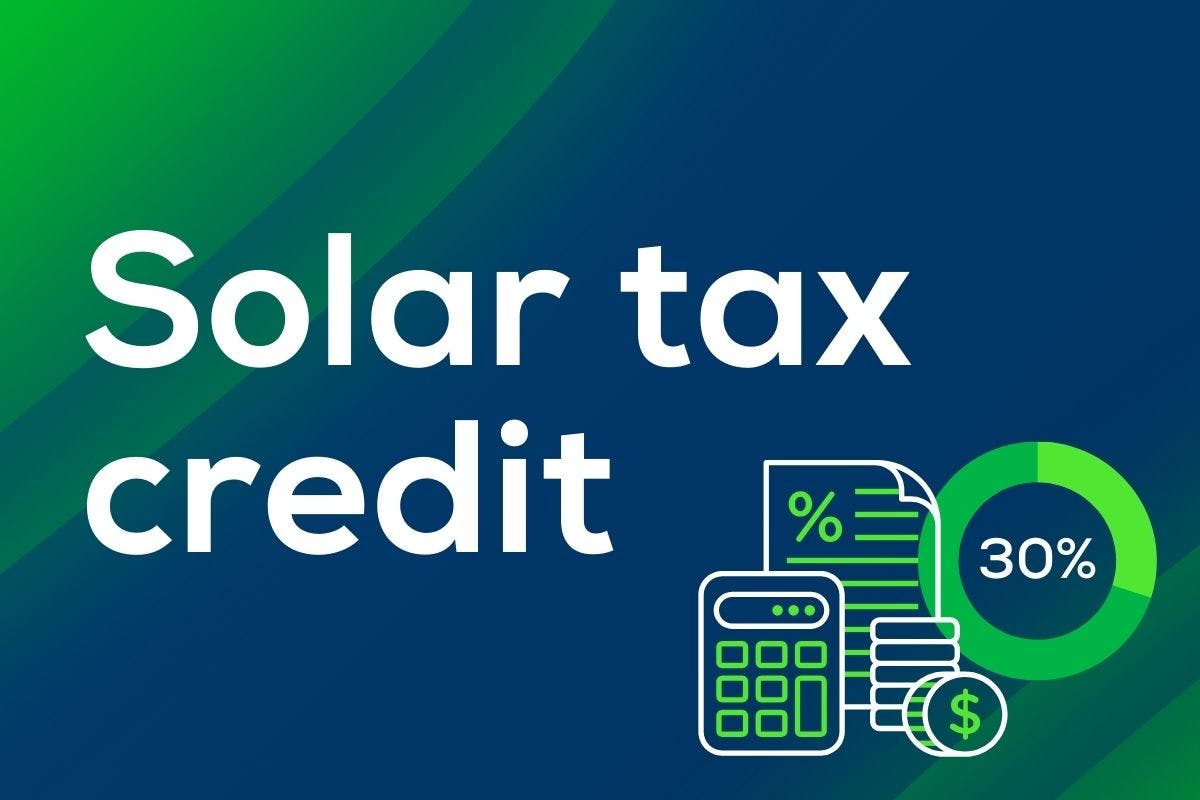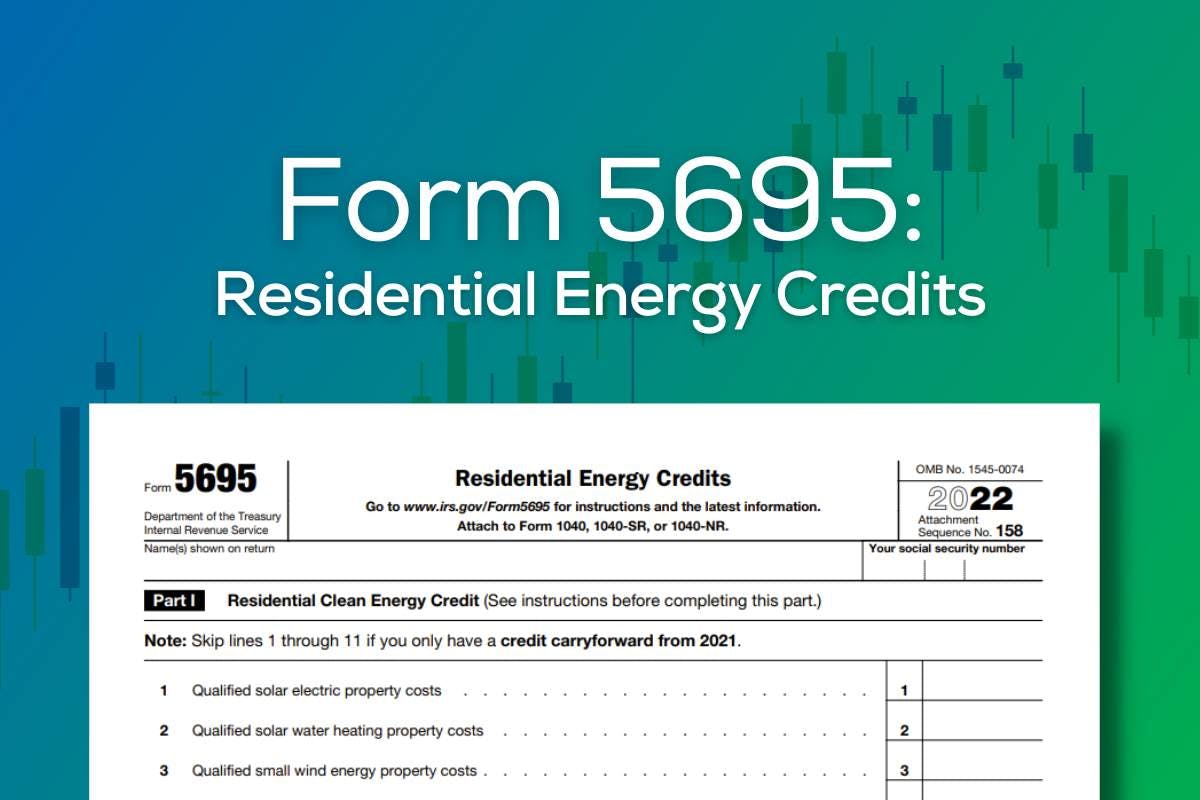Federal Solar Tax Credit: Everything You Need To Know Right Now
Last edited

Author
Andrew Blok
Electrification and Solar Writer and Editor

Editor
Ryan Barnett
SVP, Policy & New Market Development

For years, the federal solar tax credit has made home solar panels more affordable, and it’s set to continue doing so for almost a decade more.
Officially known as the Residential Clean Energy Credit, it lets qualifying solar panel owners deduct 30% of the cost of those solar panels from the taxes they owe. While the credit is broadly available, there are some restrictions on who and what qualifies for the credit. We’ll cover all that and more below.
See how much you can save by going solar with Palmetto
What is the Federal Solar Tax Credit?
The Residential Clean Energy Credit is a solar tax credit that’s like a coupon for 30% off your home solar installation, backed and funded by the federal government. While it doesn’t reduce the upfront cost you’ll pay to your installer, the Residential Clean Energy Credit can greatly reduce or even eliminate the taxes that you would have otherwise owed to the federal government in the year you install solar.
The Residential Clean Energy Credit is the current name of the solar tax credit that was originally known as the Investment Tax Credit (ITC) and was created by the Energy Policy Act of 2005. With the signing of the Inflation Reduction Act Of 2022, the ITC was renamed the Residential Clean Energy Credit, the value was increased to 30%, and the deadline was extended through December 31, 2034.
How Does the Federal Solar Tax Credit Work?
As a homeowner, you can claim a federal solar tax credit for the amount of money that you pay towards installing solar and reduce the amount you owe when you file your yearly federal tax return. (The solar tax credit does not apply to state tax or any local taxes.) The Residential Clean Energy Credit can be filed one time for the tax year in which you install your system using Tax Form 5695.

The credit received is then calculated dollar-by-dollar as a reduction of your federal tax liability, so if you receive $1,000 in credits, you’ll owe $1,000 less in taxes. Once you calculate how many credits you’ve received, you will want to add your renewable energy credit information to a typical Form 1040 while filing your taxes.
How to Claim the Federal Solar Tax Credit
A tax credit is different from a tax refund. In order to claim a tax credit, you must owe taxes to the government, so that the tax credit can cancel out some or all of the amount that you owe.
If you don’t owe any taxes (for example, if you’re retired and don’t have any income) then you wouldn’t receive any money for the tax credit, because you didn’t owe any money to begin with. If you’ve already had those tax dollars deducted from your paycheck, then you can get that money back in the form of a refund, but you’re only getting back money that you’ve already paid.
Lastly, the solar panel federal tax credit can be used against either the federal income tax or the alternative minimum tax, so regardless of how you calculate the taxes you owe, you can be eligible to claim the value of the federal income tax credit for solar.
Value of the Solar Tax Credit
In 2024, the Residential Clean Energy Credit covers up to 30% of the cost of your solar power system. However, you may be surprised to learn that there is no maximum dollar amount that can be claimed as a tax credit for your solar installation! As long as you owe enough in federal taxes for the credit to cover, you can claim up to the full 30%, regardless of how large your solar power installation is.
What does the federal solar tax credit cover?
The solar tax credit covers any product that directly connects to your solar power system or is needed for the installation, such as solar panels, mounting equipment, inverters, wires, and battery storage systems. The tax credit also covers other items related to getting panels installed on your roof, such as labor costs, assembly, installation, inspection costs, and sales tax.
For any solar project that finishes construction between 2022 and 2032, the value of the solar tax credit is 30% of the project’s cost. After that date, the step-down schedule is as follows:
- 30% - Projects where construction finishes between 2022 and 2032
- 26% - Projects where construction finishes in 2033
- 22% - Projects where construction finishes in 2034
- 0% - Projects where construction finishes in 2035 or later
Residential Clean Energy Credit case study
Let’s say you’re in the market for solar panels and you settle on a solar and storage system that costs you $18,000. It’s installed in June and you pay in cash or start making loan payments shortly after.
In March of next year, when you file your taxes (early, because you’re that kind of responsible), you use Form 5695 to calculate your tax credit ($18,000 x .3 = $5,400), complete the form, file it with your taxes, and claim a credit of $5,400.
See how much you can save by going solar with Palmetto
How to Qualify for the Solar Tax Credit
In order to qualify for the solar panel tax credit, you must own your home (not lease or rent) and you must pay enough taxes to the federal government (tax liability) that the Residential Clean Energy Credit can offset your tax payment.
For example, if you paid $10,000 to install solar on your principal residence in 2024, then the 30% RCEC would mean you are eligible for a tax credit of $3,000. In order to claim that credit, you need to have owed at least $3,000 in federal taxes before the solar tax credit. If you owe more than $3,000 then the RCEC would reduce the total amount that you owe. If you owed less than $3,000 then the RCEC would eliminate your tax liability for that year.
Second homes and rental properties
You are also eligible to claim the solar tax credit even if the solar energy system is not on your primary residence. As long as you own the property and live in it for part of the year, you can still claim part of the credit on your taxes to reduce the amount that you owe. However, if you put solar on a pure investment property, such as one that you lease out full time, you cannot claim the solar energy tax credit on a rental property.
Income brackets and the solar tax credit
There is no household income limit on the federal solar tax credit. Therefore you cannot be barred from tax credit eligibility because you make too much money or are in a high-income tax bracket.
If you are in a low-income tax bracket, then you may be able to qualify for further federal incentives to reduce your total solar investment costs.
Does the solar tax credit roll over?
If you do owe less than your total Residential Clean Energy Credit savings for the year that you install your solar system, you can actually roll over any remaining credits to the following year, so that you don’t lose the value of those credits.
For example, if you were eligible for $6,500 in tax credit, but only owed $4,000 that year, then you would completely eliminate your tax payment for that year, and the next year you would be able to deduct an additional $2,500 from that year’s tax payment as well.
What if I don’t owe taxes?
The one catch with a tax credit is that you have to owe taxes. If your tax liability is zero, the tax credit won’t have anything to offset.
If you don’t owe taxes, a solar lease may be a feasible option to get the benefits of home solar panels, even if you can’t claim the tax credit. Because the leasing company, not you, owns the panels, it will claim the tax credit. The tax credit savings the leasing company gets should translate to lower lease rates for you.

How to Claim the Tax Credit for Solar Panels
We’re solar experts at Palmetto, but everyone’s tax situation is unique, so please consult with a tax expert to determine what’s best for you. That said, if you’re looking for information on how to file for a solar panel tax credit, here’s a general overview of how homeowners can claim their Residential Clean Energy Credit:
- Determine eligibility: Make sure you have enough tax liability that you can use the federal Residential Clean Energy Credit to lower the amount you owe for taxes.
- Complete IRS Form 5695: This form is available online, and validates that you’re qualified for renewable energy credits.
- Add the credits to your 1040: Once you’ve determined your solar Residential Clean Energy Credit credit information from Form 5695, you use that total on your Form 1040 to reduce the amount you owe.
How to Maximize Your Solar Tax Credit Benefits
Make sure you’re not leaving any of your tax credit on the table with a bit of planning and persistence.
- Plan and budget for the tax credit: The potential value of your tax credit depends on the overall cost of your solar installation. So, before you tell yourself that a full-home solar energy installation is too expensive, keep in mind that a 30% reduction in total project investment costs could be right around the corner.
- Rollover as many times as you need: If you are worried about not having a high enough tax liability to cash in on the solar tax credit, remember that you can roll it over to future years. To maximize your solar savings, speak with a professional tax advisor before making any investment decisions.
- Look into other tax credits: Finally, the federal solar tax credit is not the only way you can offset your project investment costs, even if it is the best deal around. There are several other tax credits and incentives available both nationally and locally throughout the United States, which we will explore briefly below.
Other federal energy efficiency tax credits
Beyond the RCEC, your solar energy system or related home upgrades may qualify for several additional federal incentives. This includes tax credits for home battery storage technology, electric vehicles, electric panel upgrades, heat pumps, and energy efficiency improvements.
Like the solar credit, low-income households may be eligible for further savings through federal energy-efficiency incentives. Then, after implementing these solutions, it is estimated that low-income households across the country could save an average of between 15% and 35% on annual energy bills.
State solar tax credits, exemptions, and programs
Zooming in to your neck of the woods, there also may be solar tax credits or incentives available through a local government (state, city, county, etc.) or your electric utility. For instance, most states exempt the value of solar energy systems from property value appraisals so that you will not be forced to pay more property taxes after purchasing your panels.
Although some parts of the country like Texas, Tennessee, and Wyoming do not impose a state income tax, the majority of Americans do pay state taxes. So in addition to the federal solar tax credit, there are a few states with state income tax credits for solar energy installations, such as credit programs in Arizona, Massachusetts, South Carolina, and more.
See what solar can do for you:
History of the Solar Tax Credit
The current value of the Residential Clean Energy Credit is 30%. However, renewable energy tax credits have gone through a variety of extensions, value changes, and step-down plans:
- 2005 - The Energy Policy Act of 2005 created the U.S. Federal solar tax program and the residential “25D” investment tax credit equal to 30% of the qualified solar expenditures. The 25D tax credit had been set to expire just a year later but was extended for one additional year in subsequent Legislation.
- 2008 - The 2008 Emergency Economic Stabilization Act (aka the “bank bailout”) extended the ITC for eight (8) years (through 2016) and eliminated the $2,000 monetary cap on the credit amount.
- 2009 - The American Recovery and Reinvestment Act (or “Stimulus Bill”) broadened the definitions of qualified expenditures and technologies, and also supplemented the ITC with the Solar 1603 Grant program (funding since depleted) that provided payments in lieu of tax credits. These cornerstone policies are largely credited with jumpstarting growth and investment in the solar industry and sector.
- 2015 - Legislation delayed the sharp and scheduled step-down from 30% → 10%, setting up a softer decline schedule (26%-22%) in 2020-2021.
- 2020 - History repeated itself when industry advocates again delayed the ITC step-down schedule as part of the COVID relief bill. The ITC value was set to 26% in 2022, and 22% in 2023, before being scheduled to expire in 2024.
- 2022 - In August 2022, The Inflation Reduction Act extended the ITC for another decade alongside several other sustainable energy initiatives. The credit was reinstated to a value of 30% and officially renamed the Residential Clean Energy Credit.
Looking ahead: Unless the incentive is repealed or changed, the 30% Residential Clean Energy Credit remains locked in for eligible homeowners installing solar through the year 2032. Although it is then set to step down to 26% and 22% in 2033 and 2034 before expiring in 2035, the policy is very unlikely to change considering the sustained and growing support of solar adoption in the United States.
Why is the Solar Tax Credit Important?
Thanks to the ITC, the growth of the solar industry helped create hundreds of thousands of jobs, injected billions of dollars into the U.S. economy, and has helped make solar a real solution to reducing greenhouse gases. According to the Solar Energy Industries Association (SEIA), the American solar industry sustains hundreds of thousands of jobs.
Likewise, it’s helped millions of homeowners go solar. There are over 5 million solar installations in the US, according to SEIA, and 97% of them are residential. That’s a lot of homeowners reaping the benefits of cheap, clean energy at home.
How to Get Started with Solar and Claim Your Residential Clean Energy Credit
If you’ve ever considered going solar, and thought about how to get your solar tax credit, then there’s never been a better time to get started! The Residential Clean Energy Credit allows you to get money back on your solar energy system, and going solar now will ensure you get the biggest return on your investment while the solar tax credit is still available.
Over the years, solar tax credits have played an important role in influencing federal policy incentives for clean energy in the United States. The long-term stability of the Residential Clean Energy Credit will allow businesses to continue driving down costs and investing in their own growth, and by investing in solar, you will be helping create jobs and strengthen the economy, while saving yourself money in the process.
Get a free design and savings estimate to learn more about how the solar power federal tax credit may help reduce your out-of-pocket expenses. Solar panels are a great way to offset your energy costs and reduce the environmental impact of your home while giving you energy independence and control over your family’s future. Now is the time to install solar and take advantage of the RCEC!
Federal Solar Tax Credit FAQ
Here are the answers to some of the most common questions we hear from customers today regarding the residential solar tax credit.
How many times can you claim the solar tax credit?
You can only claim the solar tax credit one time for your solar power installation. If you have any unused amount remaining on your tax credit that you are unable to claim in a single tax year, you may be able to carry over that tax credit value for up to five years.
Can you claim the solar tax credit twice?
Technically you cannot claim the solar tax credit twice if you own your home. However, if you own more than one home, you may be able to claim separate tax credits for solar installations on each of those homes.
In addition, if you add additional equipment to an existing solar installation, you may be able to claim a tax credit for that added installation cost as well. In general, we always advise customers to speak with a tax professional about any specific tax credit questions, as each situation is unique.
What if my tax bill is less than my tax credit?
If your tax bill is less than the value of your solar tax credit, there is a provision that allows you to carry forward the tax credit to a future tax year. To learn more about your options in that situation, check out Solar Tax Credit: What If Your Tax Liability Is Too Small?
Does the residential solar tax credit apply to new home purchases?
If you buy a new home that already has solar installed, you can still claim the RCEC in the year that you move in, regardless of when the house was originally built or sold. For example, if your home was built in 2020, and then you bought it in 2021, but didn’t move in until 2024, then you would claim the Residential Clean Energy Credit on your 2024 taxes.
Keep in mind, the RCEC can only be claimed once, so you’ll want to check and make sure that your builder hasn’t already claimed the credit. If your builder has claimed it, then you may be able to ask for a reasonable allocation for those costs, and factor that into the final purchase price.
Can you claim the solar tax credit if you lease your solar panel system?
If you lease your solar panels, you do not qualify for the Residential Clean Energy Credit directly. Because the solar company owns the panels, they will typically receive the solar tax credit, and the homeowner won’t qualify for the tax incentives. However, the company that you lease from may use that tax credit to help lower your monthly payments.
See what solar can do for you:
Disclaimer: This content is for informational purposes only. All content mentioned does not constitute professional advice and is not guaranteed to be accurate, complete, reliable, current, or error-free. Palmetto does not provide tax, legal, or accounting advice. Please consult your own tax, legal, and accounting advisors.


